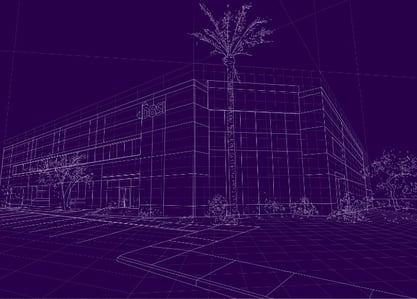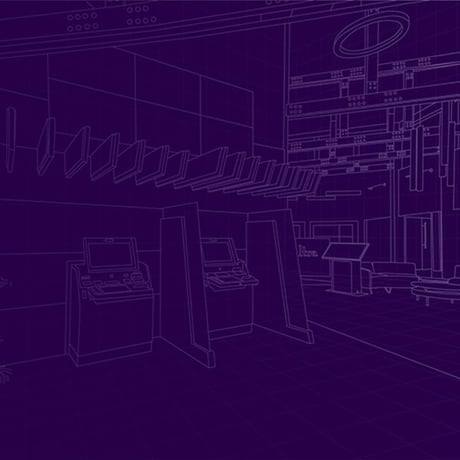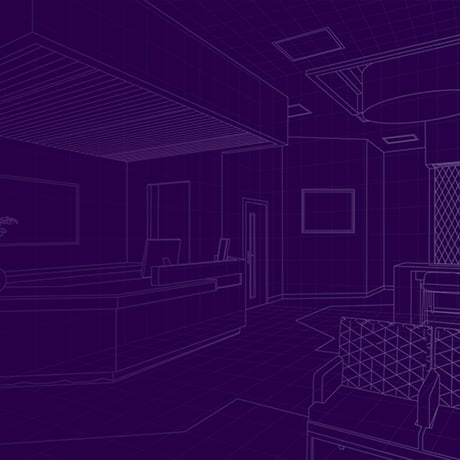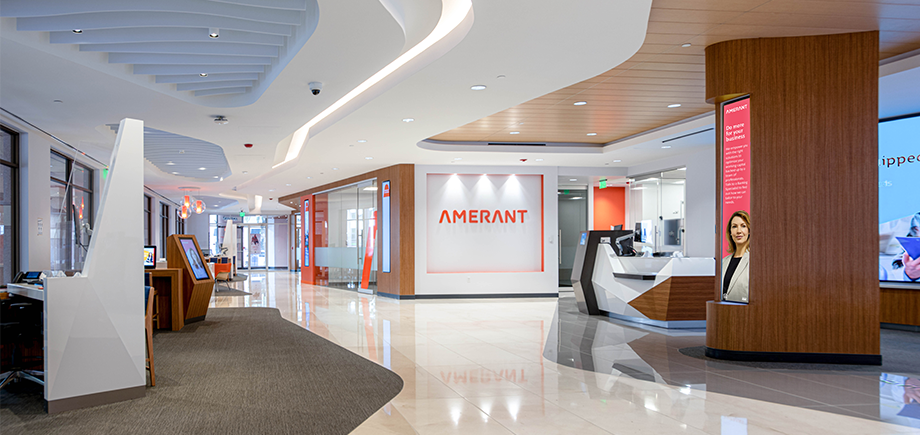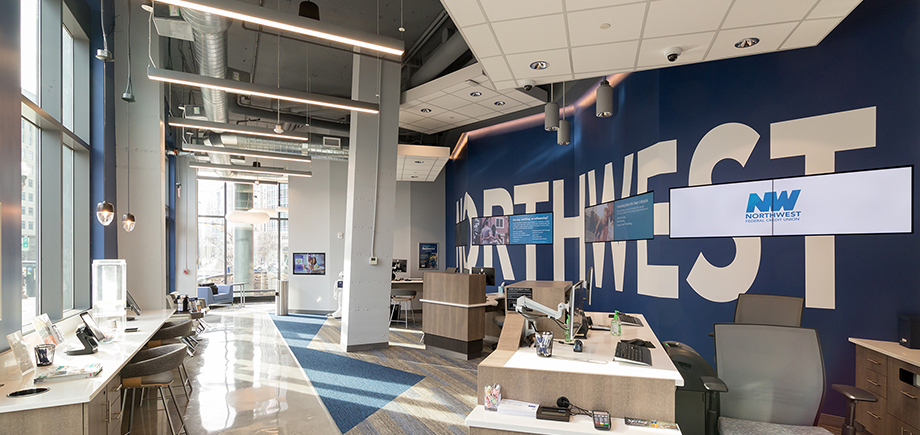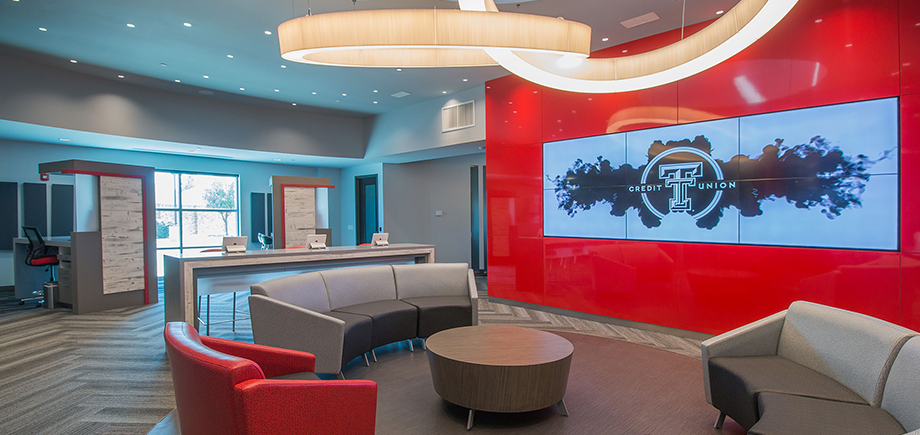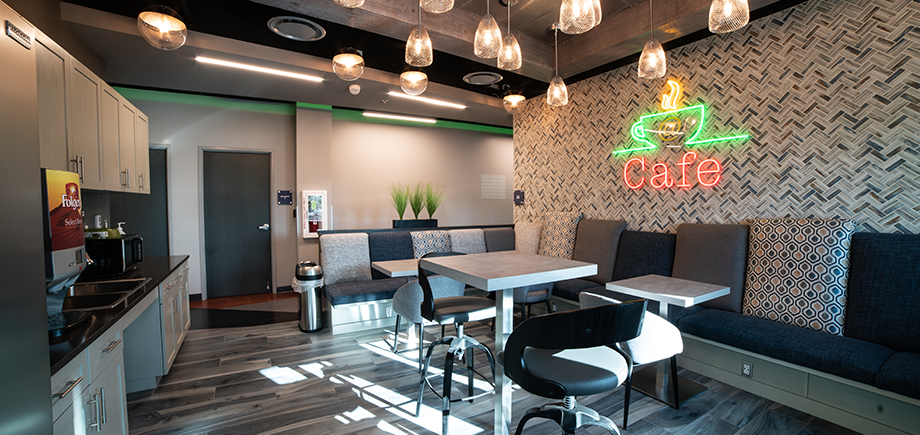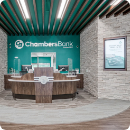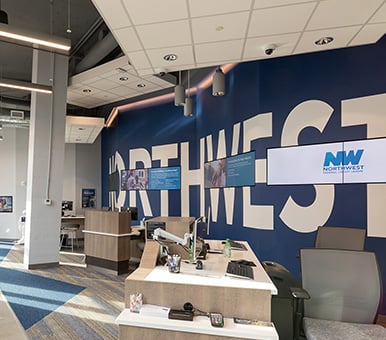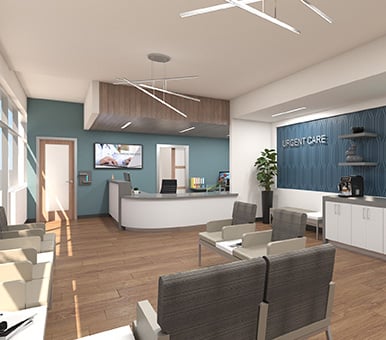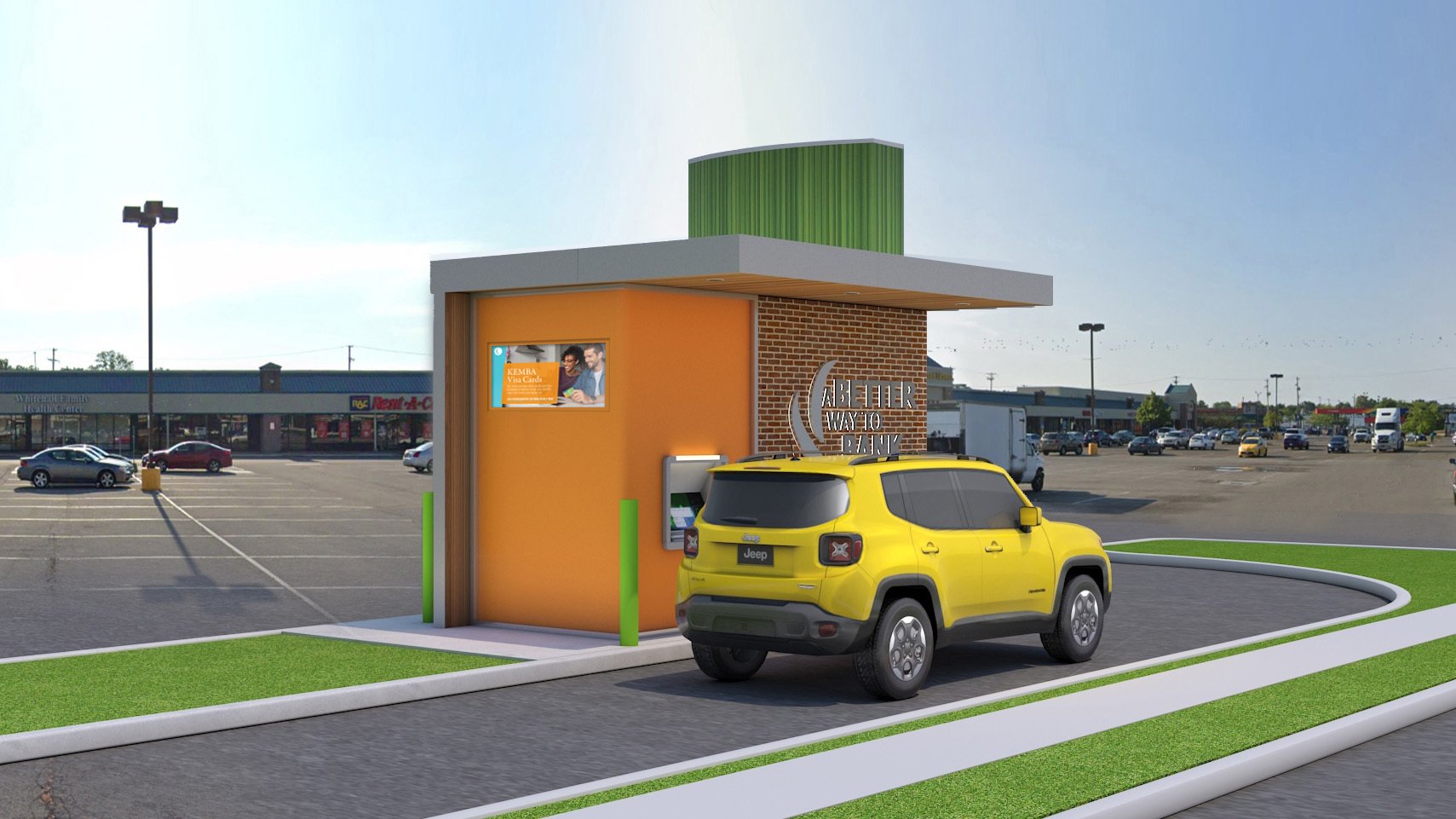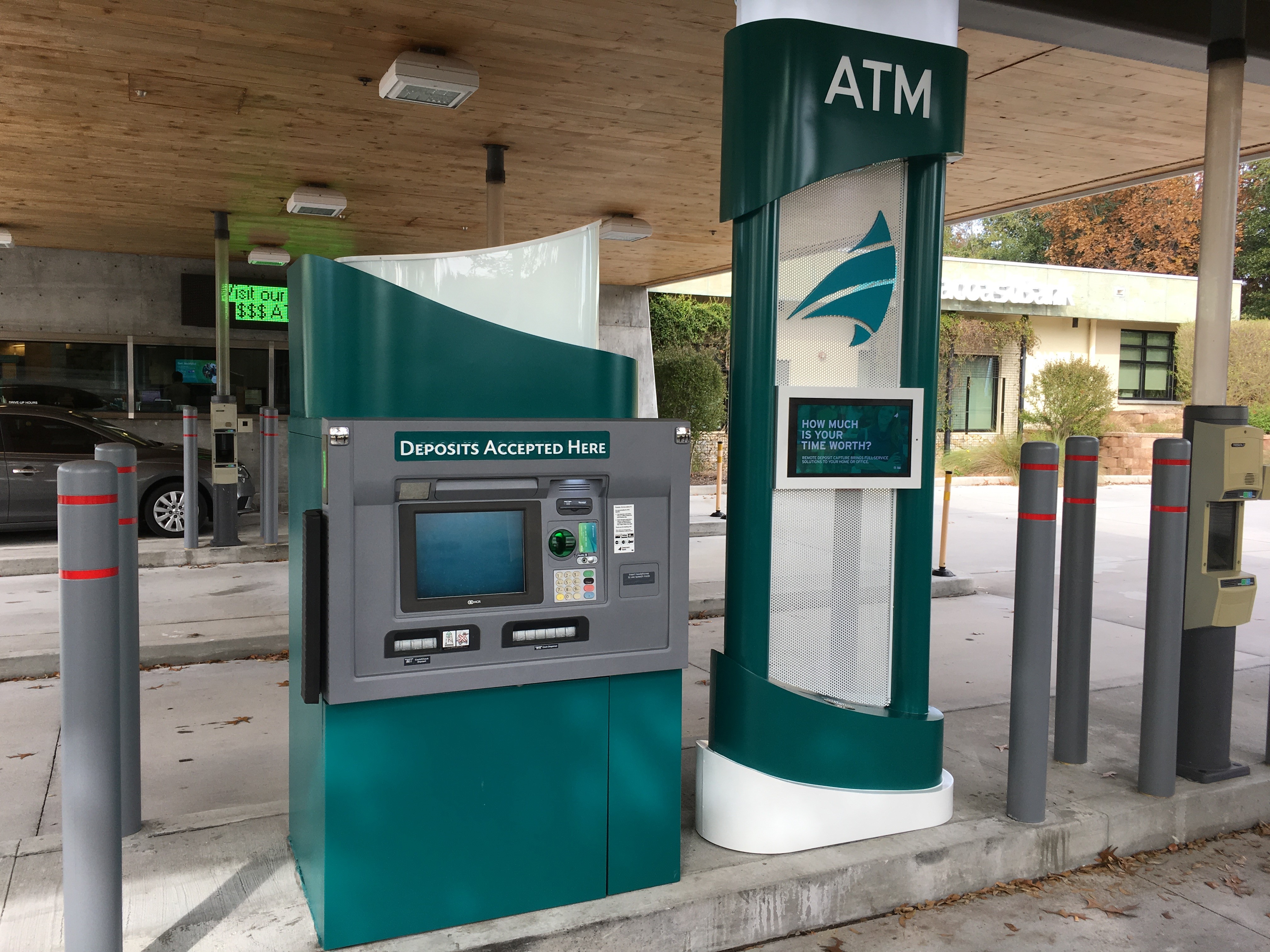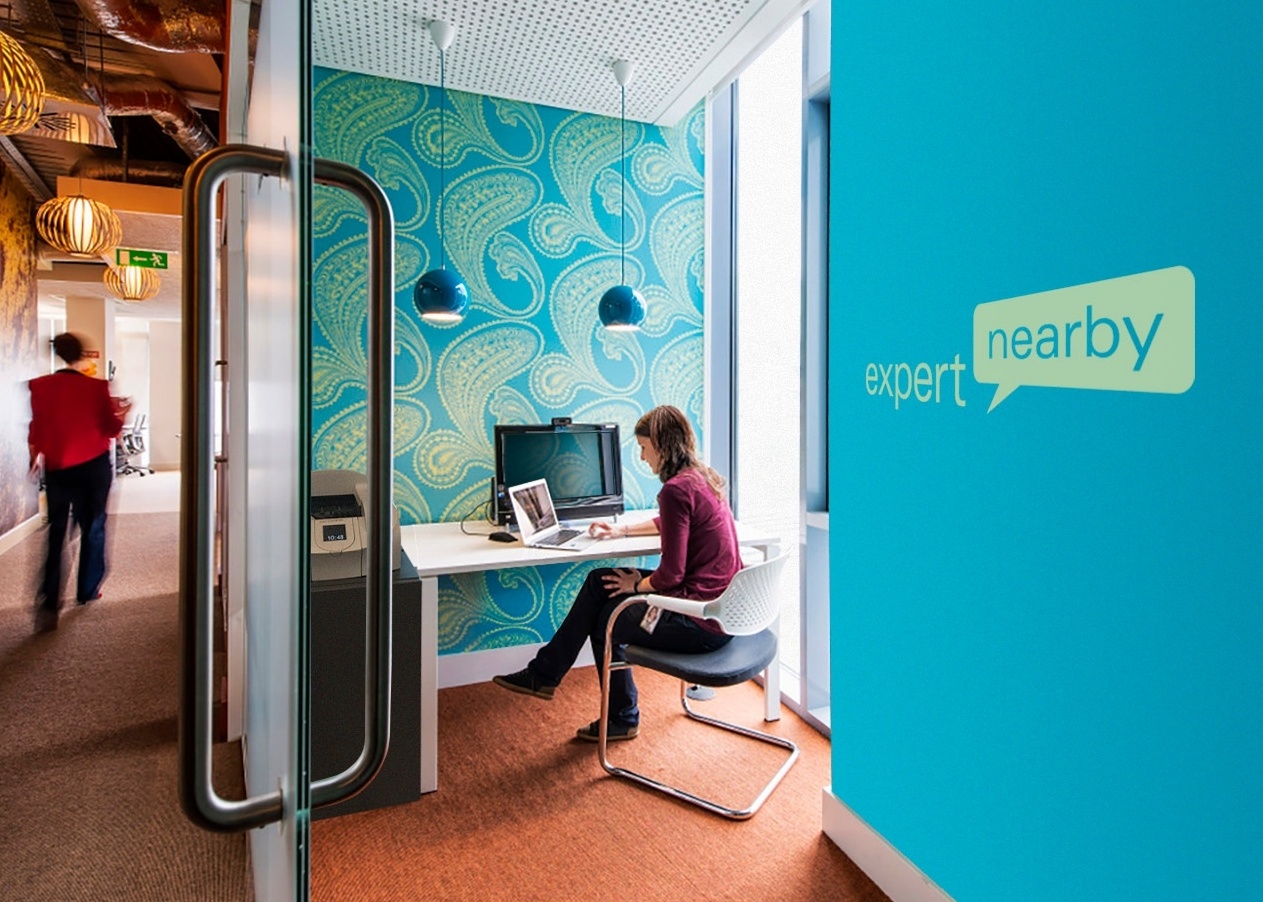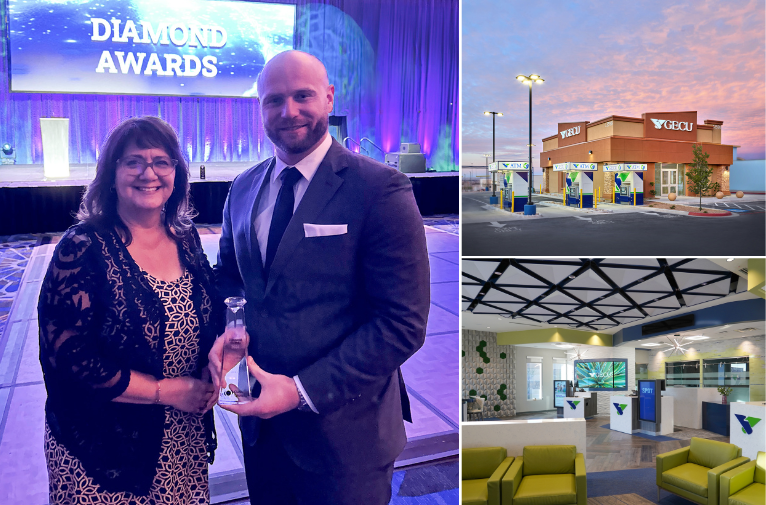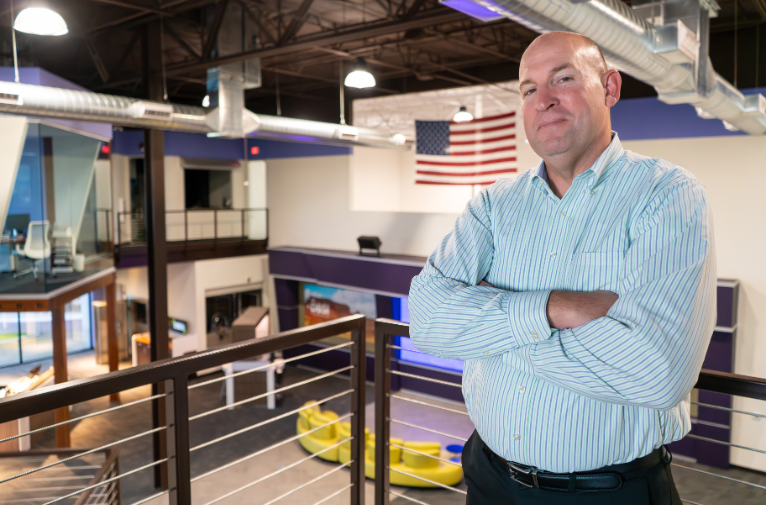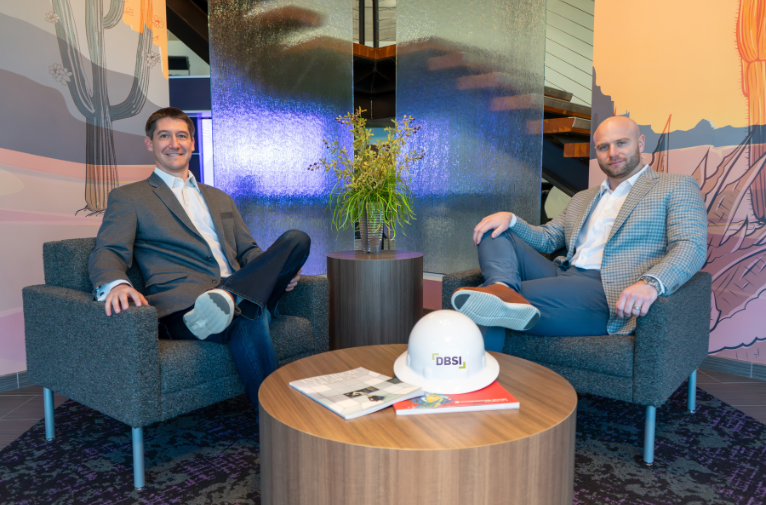11 min read
8 Ways to Improve the Customer Experience in Retail Banking | DBSI
 Janice Bourbon
:
7/15/21 7:15 AM
Janice Bourbon
:
7/15/21 7:15 AM

Did you know that over half of the US population (51% to be exact) believe their financial institution does not provide a good client experience today? (Financial Brand)
Today’s clients don’t want to bank with a provider that has stale branches and lackluster service. They want their establishment to have retail-friendly branches. More specifically, your clients want fast and efficient transactions with personalized service and the latest designs, technologies, and processes that make banking more convenient. It’s now up to you to design future branches with those conveniences—especially if you want to be one that survives and thrives.
Are those too afraid to make the shift towards retail banking? Well, they’ll get left behind.
8 Ways to Improve the Customer Experience in Retail Banking
1. Focus on educating clients through their financial journey, not just completing transactions.
You’ve heard the phrase, “shift from transactional to advisory”, and this is likely not a new idea for you, so we will just briefly highlight this way of improving client experience (and if this idea is new to you, you’ve got some catching up to do, so you should check out some of these other blogs).
And the facts support the need for this shift in servicing too:
- 80% of US bankers want to receive financial guidance and ongoing advice from their financial institution (Accenture).
- 71% of clients would give their bank or credit union more business if their advisory services were better (Celent).
- 82% of retail clients say they would place more trust in their financial institution if it provided annual continuing education (UnBlu).
Yet no matter how supposedly accepted this shift is in the industry, as of 2020:
- 70% of consumers still consider their relationship with their bank to be transactional in nature, rather than relationship-driven (Evergage).
- Only 29% of clients trust their banks to look after their long-term financial wellbeing (Accenture).
- 1/3 of high-net-worth clients say they are unsatisfied with the quality of financial advice offered by their main bank, leading to one in five moving their assets to another bank during the pandemic (McKinsey).
As you can see, there is a big gap between what your clients want (and need) and what they feel is being delivered to them. There are a few ways you can change that, and they all lead back to shifting the focus away from completing transactions and towards creating a high-value, advisory relationship between the client and the associate:
- Train staff on all the solutions and products you offer, but also how to look for advisory opportunities in conversations and not just how to complete transactions. The more they feel comfortable on the floor and in sales-like conversations, the more they will be able to help your clients
 .
. - Provide educational content to your clients via in-branch messaging, online messaging, email marketing, and more. Focus on specific life events, like paying for college or buying a house, and be sure to include valuable advice, not just promotional tips and tricks. You can even provide interactive solutions, like financial quizzes and games (for both adults and kids) that can be taken both online and in the branch.
DBSI’s Financial HealthCheck is a great example of one of these tools, serving as a tool for clients to assess their financial state in comparison to others in their area, and for staff to gather valuable insight into the financial goals of their clients. - When it comes to offering a more advisory experience, there is no better way than rolling out Universal Associates. However, instead of going into any more detail here, our entire next point is dedicated to rolling out this model, so just read on...
2. Offer a more seamless branch experience with Universal Associates.
Over the past decade, changes to customer service in the retail world have resulted in greater consumer expectations. Restaurants, movie theaters, and other retail industries have already adopted universal-based models, which means your clients have already been enjoying an advanced level of service while going about their daily business. In fact, 86% of banking consumers want responsive customer service, so if you don’t evolve to what they are already used to experiencing, your clients will quickly see you as outdated and find a more modern provider (Celent). So, forget about tellers and bankers and greeters and loan officers and and and.
More and more financial institutions are shifting toward the Universal Associate Model to evolve their branch experience and better connect with clients. In hundreds of branches across the country, this new approach to servicing clients has created a repeatable path to success by decreasing costs, increasing staff flexibility, and supercharging client engagement. But what is this model and how does it actually work?
We’ll start with the what (or perhaps the who). Whether you call them universal associates, universal tellers, or universal bankers, this role is best defined as an employee that can handle just about every type of transaction in the branch. Instead of specializing, a UA’s lack of specialization is precisely what makes them special.
The UA role can vary from branch to branch, but the job responsibilities remain similar in the course of a day, a typical universal banker will provide customer service, greet clients, process basic transactions, open and close new accounts, and even process loans applications. And regardless of the task or transaction(s), they are completing, they always have one goal: to advise their client.
When looking at the benefits of this more universal role, there are a ton of them, but when talking about offering a better in-branch experience, there is one benefit especially worth highlighting: the removal of siloed roles allows for one associate to help a client from the minute they enter the branch to the minute they leave, eliminating the cold hand-off and opening the door for a more high-value interaction. Shifting from transactional to advisory has never been this easy.
Pro Tip: You can build the perfect branch and have an experienced team of universal bankers, but if you don’t have the right technology you won’t be able to take advantage of the universal model’s biggest benefit: flexibility. To maximize the universal experience in your branch, you’ll seriously want to consider a way to initiate transactions remotely, which requires a solid core integration and cash recyclers. Our sister company, CFM, has created two technologies to help you do just that:
- Remote Transaction Assist (RTA) - One way to break the chains of these peripherals is with Remote Transaction Assist (RTA), pronounced ree-ta, a CFM innovation that drives the future of retail banking by using pin pad and queuing technology to make your cash dispensers and recyclers available to all your tellers and associates–from any spot in the branch. Now, whether staff are standing right next to a cash machine, working in an office, or greeting in the lobby, the clients can be served from start to finish.
For a great example of how all of this comes together, take a look at Pioneer Federal Credit Union’s journey to becoming completely universal. They moved to an open branch design, implemented universal representatives, then added RTA to create a truly universal model that skyrocketed their staff and client experience.
- NOMADIX - Another technology found in a universal branch that is known for providing fluid transactions (and referred to as the next level up from RTA) is CFM’s newest addition: NOMADIX. A core-integrated, tablet-based application that decreases your footprint and unlocks the chains of teller lines and workstations, this application allows universal associates to complete transactions from anywhere in the branch and easily choose when and how they engage with peripherals such as scanners, recyclers, and printers.
See how NOMADIX works in this short video:
3. Strategically deploy creative, relevant, and engaging digital signage.
"There's nothing like waking up on a Sunday morning to research your primary financial institution's banking products," said no one, ever (probably).
Let's face it... getting the skinny on the latest ways to improve your financial health isn't only snooze-worthy reading material for most clients but isn't a priority. When it comes to getting advice outside of the branch on how to reach financial goals, most people won't get past page one of Google's search engine results.
But when clients visit the branch, it's a completely different ball game.
You can't control what content they see when they walk out of your doors...but when clients visit the branch, this is your time to shine and give clients the right tools to learn, ask questions, and find solutions that can help them achieve their financial goals and aspirations. Forget about brochures, because we all know those end up in the trash or that one pile on your kitchen counter with miscellaneous papers that "you'll take a look at soon," but keep stacking up. How about a new approach? The days of paper marketing materials are over.
Do everyone a favor and please just leave those dirty, outdated, non-eco-friendly, wrinkled pieces of information in the past. Instead, you should be investing in digital signage solutions, by:
- Placing interactive digital signage kiosks in the lobby that offer digital brochures and other types of information on products and services.
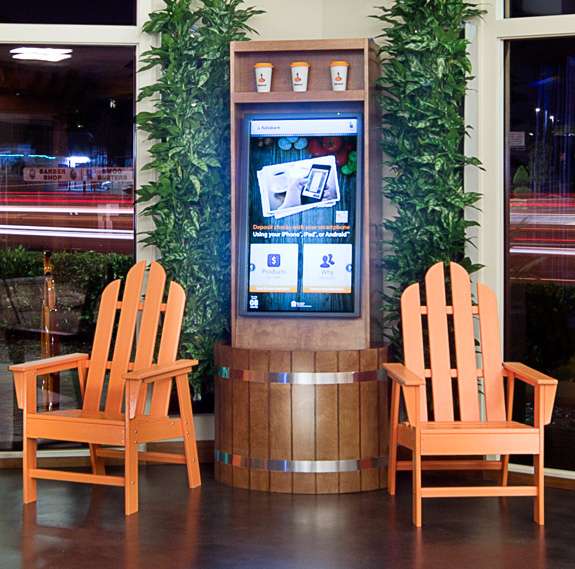
- Using a digital community board to provide updates on branch and community events, promote other local businesses, social posts, and more

- Hanging a Wow Wall or other large digital signage and dynamic displays in heavily trafficked waiting areas to not only advertise products and services but also display other imagery that embodies the brand and the community
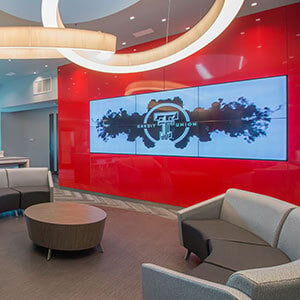
- Providing tablets for staff to onboard clients to online banking and teach them how to complete their most needed transactions from the tablet—or even their own device.
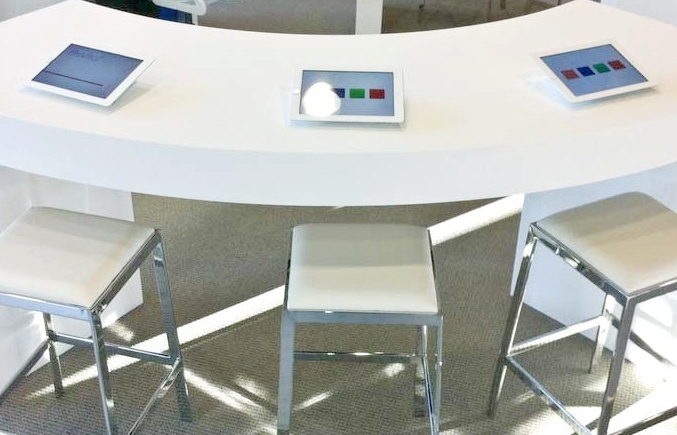
Whatever type of display you choose, it is time to make the transition from static, unengaging, and empty messaging to valuable, relevant and impactful messaging. Not doing so can cost you in clients, sales, and operation dollars.
Fun fact: 72% of banks and credit unions currently using digital signage in their branch(es) say it has improved their sales efforts (DBSI's 2020/21 Digital Signage Benchmark Report).
4. Deliver ultimate convenience by providing a variety of ways to complete transactions.
Financial institutions are in need of a solution that provides customers with the personal touch they require for a positive experience without requiring a costly 1:1 interaction with a teller or associate just to complete a simple transaction. Self-service solutions are what most financial institutions are turning to. But when it comes to these machines, it is not one size fits all. In fact, there are several solutions for self-service technologies, all with their own pros and cons. The most popular include:
- ATMs - You work for a bank or credit union, so we don’t need to tell you what an ATM is.
- ITMs - Also known as Interactive Teller Machines, ITM’s are regularly replacing ATMs in modern branches looking to step up their self-service game. Not only do they provide the capabilities of a traditional ATM, but they also have two-way video communication capabilities—meaning clients can interact with a teller or associate from anywhere at any time. Around here we call them drive-thru kings because they bring top-level service standards out to the client’s car.
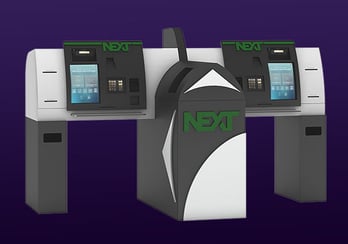
- SSK - This fully core-integrated self-service software that can be placed into the hardware of your choice is capable of self, assisted, and full-service. This means your clients now have the power to complete almost any transaction a teller could, and your associates can better spend their time focusing on more high-impact, advisory interactions.
- NEXT – Remember how we said that SSK could be placed into any type of hardware that you prefer? Well, when it comes to offering a better in-branch experience, we prefer the NEXT machine. And if you are operating on the Universal Associate model, NEXT can be paired with NOMADIX, our tablet-based teller application, for effortless, assisted, or full service.
5. Step up your drive-thru service with digital signage.
If other industries are an indicator of consumer preferences, including quick-service restaurants like Starbucks and Mcdonalds, it seems drive-thru traffic won't be slowing down anytime soon. And besides having drive-thru lanes in general, banks and credit unions can take another page from these business giants' playbooks by adding digital signage to capture more client attention.
As we mentioned above in #3, digital signage has a ton of uses (all with their own benefits), with the most prominent for drive-thrus being:
- Promotional materials that increase awareness to products and services.
- Educational content to guide clients along their financial journey.
- Highlights of important company information, updates, and more.
And what exactly do these digital displays look like in a drive-thru setting? Well, there are a few options, with the most popular being:
Pillar Screen(s) - For traditional drive-ups, adding weatherproof, ultra-bright screens to pillars is a highly visible way to increase the appeal of your products.
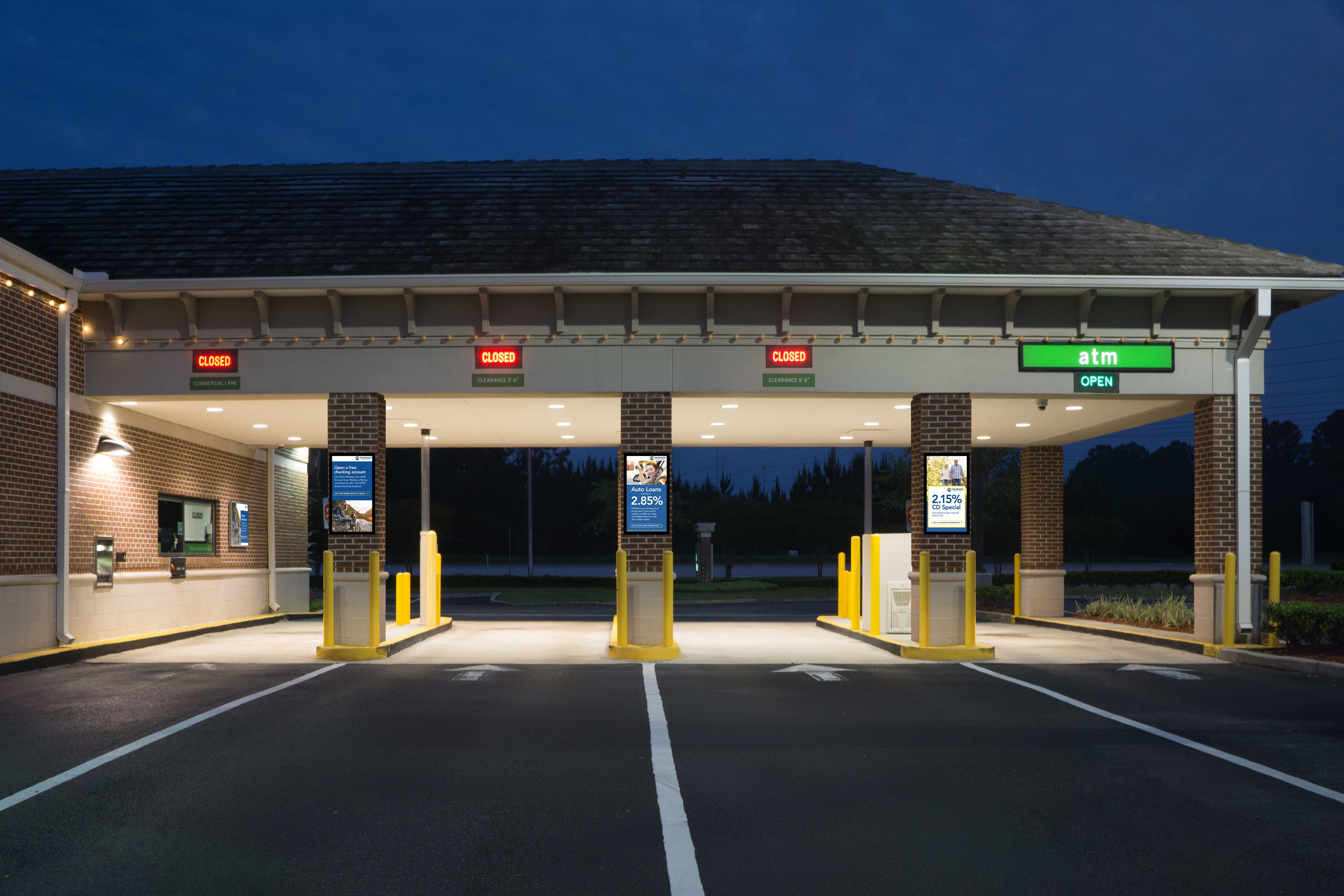
Standalone Screen(s) - Another cost-effective option is to consider adding dynamic screens to your standalone ATM or ITM kiosks to get the eyeballs of people pulling up or waiting in line.
Complementary Screen(s): One more way to grab attention is to get up close and personal with mini-screens placed next to your ATMs and/or ITMs. These can be installed in your existing fixtures and are guaranteed to be seen by clients.
6. Offer clients real-time access to specialized bankers with video banking technology.
Daily, clients are visiting your branches with hopes of speaking with an expert capable of handling their banking needs, like opening a loan. And daily, clients leave your branches disappointed after being informed the expert they hoped to speak to is only in the branch on Tuesdays and Fridays.
So how do you solve this? With Expert Nearby, small offices or private spaces can be turned into a virtual meeting space where clients can communicate with any expert from anywhere using a video conferencing tool known as Pop.io.
Not only will clients be able to access experts trained and with the authority to complete their specific needs, but they’ll also get the required privacy with added convenience. And beyond offering ultimate convenience for clients, Expert Nearby also provides your staff (and your institution as a whole) with quite a few pros as well, including:
- Connecting an entire branch network of experts
- Offering full service at all branch locations
- Increasing the number of client interactions
- Growing revenue by reducing “walk away” losses
- Creating more brand value
- Reducing travel and branch staff costs
7. Get closer to where your clients stay, play, and work with micro-branches
Do you really need a branch that’s 4000 sqft to create a great client experience? The answer is no. In fact, in today’s climate, a branch that size is only costing you money—and if you were able to secure that much space, we can almost guarantee it isn’t conveniently located in a high-traffic area.
And as the saying goes, convenience is key. Especially for offering a killer client experience. In fact, when it comes to choosing a primary banking provider, convenience is the #1 reason people choose a bank or credit union. When asked to define what makes a provider convenient, branch location was the leading answer, with 89% of respondents. To take it a step further, over half (56%) of clients will not open an account at all with an FI that has no, or limited, local branch locations (DBSI’s Transformation University 201).
So it’s safe to say that the closer your branch is located to where clients spend their time (working, living, visiting, and more), the more likely they are to not only choose you as their provider but also keep you as it too.
But building a branch on every corner is simply not financially feasible, and even if you had all the money in the world there just isn’t enough availability in space. So how do you solve for this? The answer: micro-branches.
Micro-branches are fully operational, advisory-focused spaces under 1,500 sqft (with the industry averaging just over 800 sqft) that can be placed in the most unique spaces to service clients where is most convenient to them. For example, these small branches work great inside of corporate centers, on college campuses, at the front of a grocery, or just up against a wall in a mall.
Here you can see a micro-branch that was creatively placed under a staircase in the middle of a corporate headquarters building:
-1.jpg?width=4771&name=BCU-TechDrive-6%20(4)-1.jpg) 8. Keep your eye on leading retail establishments in your local area(s).
8. Keep your eye on leading retail establishments in your local area(s).
This one may sting a bit, but trust us, it will be worth it. The average American has 16 banking products in their household, but only 2.5 of the products are with their primary financial institution (Celent). That's a lot of potential per household! So how do you gain more market share and win your client’s continued business? By staying at the top.
Your competition is constantly innovating so that means you must be the exception to beat them. Your in-branch experience needs to rival even the best retail giants and deliver on client's expectations. Some of the best ways to do that:
- Dedicate a few hours a month to competitor research. What’s working for them and what isn’t?
- Spend time reading news and resources on both the banking and the retail industry. What’s popular and what’s not?
- Subscribe to The Banker’s Playground for monthly weekenders (and other regular pieces of content) all about retail banking, design, tech, staff training, and beyond.
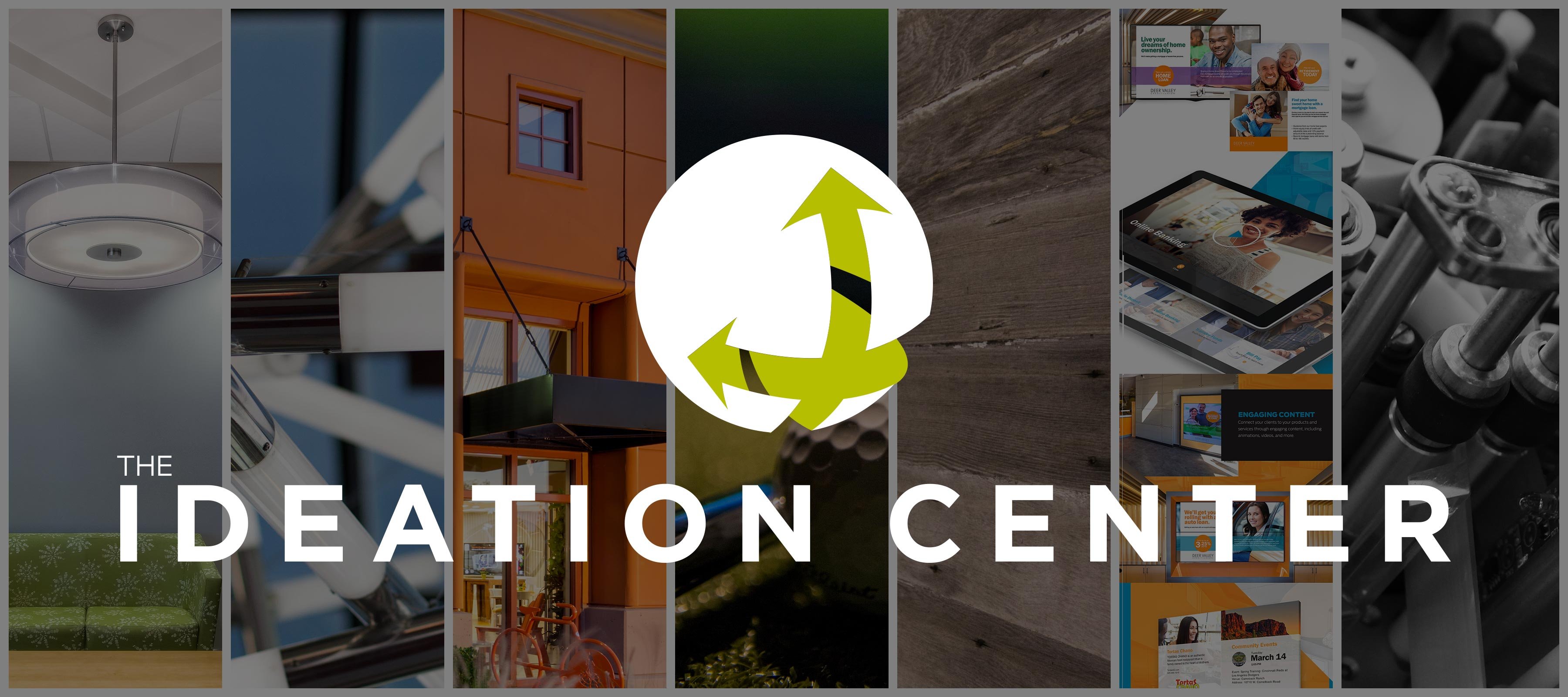 Come Experience the Future of Retail Banking
Come Experience the Future of Retail Banking
If you’re looking to step up your client experience and offer an ultimate retail-friendly branch environment, it’s time to book your flight(s) to sunny Arizona. Located in the heart of the desert, the Ideation Center is the only place where you and your entire executive team can get a hands-on look at so many banking strategies. And unlike the slow growth of a Saguaro Cactus*, The Ideation Center is famous for jumpstarting transformation efforts.
Also known as the Banker's Playground, the Ideation Center is an interactive showroom with the latest design-build, digital signage, and banking technologies where banking leadership teams start their journey toward branch and headquarter transformation. And unlike at conferences, project teams can learn, strategize, and create with award-winning designers, engineers, and technology experts one-on-one and hands-on.
*Saguaros reach adulthood at 125 years. That’s slooooow!
Why visit?
- 1000+ banks and credit unions started their transformation journey at the Ideation Center.
- 10/10 banking executives recommend a trip to the Ideation Center when starting a new project.
- 1 day at the Ideation Center can save you and your team months of expensive (and stressful) planning and re-planning with direct access to experts and unmatched educational materials.

